15 Crane Species Examined: The Most Amazing Birds On The Planet
The Crane, family Gruidae, are among the most amazing birds we have on this planet.
With their large stature and loud resounding calls, cranes have appealed to mankind whenever we have met.
In prehistoric times primitive peoples in Africa, Australia and Europe painted images of cranes in caves.
In more recent times, The Ancient Egyptians decorated their tombs with images of cranes, the Ancient Greeks domesticated cranes and there is a Greek myth that the Greek God Mercury invented the Greek alphabet after seeing a crane fly.
A dance called ‘A Dance of the White Cranes’ is known to have been performed in China 500 years BC, around the time of Confucius and Lao Tzu.
Other ‘Crane’ dances are known from Australia, the Mediterranean and Siberia.
Throughout China and other parts of Asia, cranes symbolise longevity and marrital fidelity. The Emperor’s Throne in Beijing’s Forbidden City is flanked by statues of cranes, while bridal dresses in Japan are still decorated with images of cranes.
American Indians are believed to have first developed Crane Clans a few hundred years before Europeans arrived (Hopis and Zunis). While cranes were totems for the Ojibwa and perhaps other groups.
In Australia, the Brolga was a totem animal to many of the Aborigines.
They have various myths that claim the word Brolga was originally the name of a young woman who was a great dancer.
It states that she was a very beautiful young woman who – through her love of dancing – became the best dancer in the whole country. Many people came to see her dance, and many men wanted her. Among them was an evil magician or spirit called Waiwera – who stole her away in a whirlwind because she wouldn’t accept him.
When her tribe tracked her down, to try and win her back, he carried her off even further – up into the skies and she was never seen again.
However, the Gods thought it was a shame that the world should be deprived of her beauty and dancing. So although the evil magician got her body, they sent her spirit back into the world- in the form of a beautiful dancing bird so that people could love her forever…
And this is how the Brolga came to be.
Even in parts of the modern world, Cranes are still revered.
In Nigeria, The Black Crowned Crane is the National Bird. Uganda has the Grey Crowned Crane as its National bird and in South Africa the Blue Crane is similarly honored.
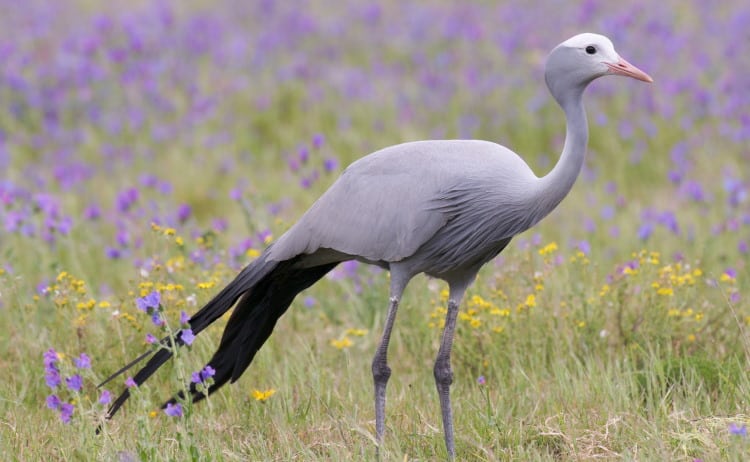
Nowadays, the hunting and killing of cranes is illegal in most countries. Yet in the last decade of the 20th century Peter Matthiessen was able to find evidence of crane hunting in several of the countries he visited.
Despite the long history of crane veneration, cranes have always been used as food occasionally. And it is likely that only the precepts against killing animals in the Buddhist religion has protected the crane in many parts of Asia and India.
Unfortunately, the industrial revolution of the last 200 years and its consequent social evolution has drawn us away from nature and religion. While at the same time greatly increasing our ability to kill wildlife – and more damaging in the long run – to destroy natural habitats.
As we lose touch with the forces of nature that created us, we lose our respect and awe of the other living things around us.

Cranes then, perhaps more than any other group of birds, exemplify the battle being fought in the collective mind of our species.
The thoughtless efforts of many businessmen and politicians, along with the hunger and desperation of hoards of displaced and debased common peoples, has placed 7 of the 15 extant species of cranes onto the ICUN Red Data Book lists.
On the other hand: the dedicated work of a smaller minority of ecologically aware, more spiritually alive, individuals has assured that – while Cranes are most definitely endangered – they are not yet extinct.
The most seriously endangered of the 15 species is the Whooping Crane of North America.
In 1941 only 15 were known to be alive. Through careful management and protection this number has now (2000) increased to around 350 birds – including those in zoos.

While this is a great success story for the cause of conservation, it is still very few birds. The Whooping Crane exists as two main populations, plus about 90 birds in captivity.
The first part is the remaining natural population which breeds in Canada’s Wood Buffalo National Park – and overwinters at several locations in Southern USA and Northern Mexico.
The second part of the population is a non-migratory population that was artificially created in Florida, USA from excess eggs.
Whooping Cranes in captivity generally lay two eggs, but only raise one chick. Conservationists can remove the excess egg and incubate, and then raise it. All the time taking great care not to be seen as human by the young birds (the carers dress up as cranes), so that they do not become too tame.
The second rarest species is the Red-crowned Crane from Eastern Asia.
In the year 2000 the population of this species was estimated at 1,800 individuals, divided between two populations.
The larger portion of the population consists of migratory birds that breed in temperate wetland in Eastern Asia and overwinters at various coastal, or near coastal – locations in China, both North and South Korea and Japan. The second population is a non-migratory population of about 600 birds on the island of Hokkaido Northern Japan.
Identifying Types of Crane
The different types of crane in the world can be identified from the varying patterns of red, grey, black and white on their heads (see more about bird identification)
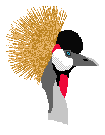 |
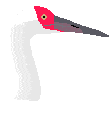 |
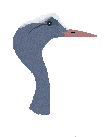 |
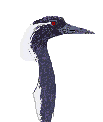 |
|
| B. regulorum | B. pavonia | G. leucogeranus | G. paradisea | G. virgo |
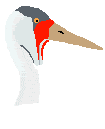 |
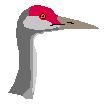 |
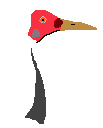 |
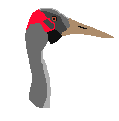 |
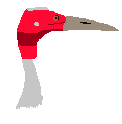 |
| G. carunculatus | G. canadensis | G. vipio | G. rubicundus | G. antigone |
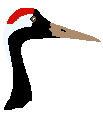 |
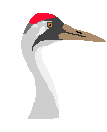 |
 |
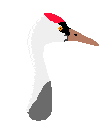 |
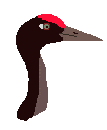 |
| G. japonensis | G. americana | G. grus | G. monarchus | G. nigricollis |
All 15 species of crane are large, elegant, long legged birds. Their calls can in some instances be heard from over a kilometer away.
They are majestic in flight and spectacular in the courtship dances. They are birds that are eminently worthy of being saved.
Crane Population Sizes and Distribution
| Common Name | Scientific Name | Population Estimate | Breeding Distribution | Overwintering |
|---|---|---|---|---|
| Black Crowned Crane | Balearica pavonina | 75000 | East Africa | Non-migratory |
| Grey Crowned Crane | Balearica regulorum | 90000 | West and Southern Africa | Non-migratory |
| Demoiselle Crane | Anthropoides virgo | 230000 | Eurasian Steppes (Black Sea to N.E. China) | East-Central Africa |
| Blue Crane | Anthropoides paradisea | 12,000 + | Southern Africa | Non-migratory |
| Wattled Crane | Bugeranus carunculatus | 14000 | West and Southern Africa | Non-migratory |
| Siberian Crane | Grus leucogeranus | 3000 | N.Eastern Siberia1 | Yangtze River in China |
| Sandhill Crane | Grus canadensis | 650000 | Eastern Siberia, Canada, Cuba2 | Southern United States and Northern Mexico |
| Sarus Crane | Grus antigone | 9000 | India, Southeast Asia, Australia | Non-migratory |
| Brolga | Grus rubicundus | 20,000 + | Australia | Non-migratory |
| White-naped Crane | Grus vipio | 5000 | Eastern Russia (Daurian Steppe, Amur River Basin) | Kyushu Is. Japan, Yangtze River Valley |
| Hooded Crane | Grus monachus | 9500 | Eastern Russia (Daurian Steppe, Amur River Basin) | Kyushu Is. Japan (mostly) |
| Eurasian Crane | Grus grus | 200000 | Europe, Asia, Russia | Patchily from S.France -east- to S.E. China |
| Whooping Crane | Grus americana | 350 | Central Canada | Southern United States and Northern Mexico |
| Black-necked Crane | Grus nigricollis | 6000 | The Tibeten Plateau | Lowland Tibet |
| Red-crowned Crane | Grus japonensis | 1800 | Eastern Russia (Amur River Basin), Japan | China, Korea and Japan |
Crane Evolution
The 15 extant species of cranes are all collected together in the family Gruidae.
At subfamily level, they can be dived into two groups – an ancestral group and a modern group.
The ancestral group contains only the two species of Crowned Cranes in the subfamily Balearicinae. The remaining 13 more modern cranes, often referred to as Typical Cranes, are in the subfamily Gruinae.
The Crowned Cranes first evolved somewhere between 37 and 54 million years ago (MYA). They are distinguished from the more modern cranes by their intolerance for cold, their uncoiled trachea, quieter calls, longer prehensile hallux and arboreal roosting.
They occur exclusively in Africa where they were once much more common than they are now. Nine other species of Crowned Crane are known from the fossil record.
The Typical Cranes first appear in the fossil record from 24 MYA and the last species became separate only about 5 MYA. Several species have one or more distinct subspecies – which may in time (a few million years), if they remain genetically isolated, become new species.
Typical Cranes are often larger, have coiled trachea and louder calls and never roost in trees. They can be found all over the world, except for the poles and S. America.
Seven other species are known from the fossil record.
For information on distribution and population numbers, and also for information on physical sizes of Cranes, see the tables further down below.
General Biology
Cranes are all long legged birds, with long necks and largish bills.
All cranes are omnivorous, meaning they will eat a wide variety of foodstuffs – depending on what is available.
Some species feed predominantly on vegetable materials – mainly seeds and tubers. Although they will all (to varying degrees) take insects, crustaceans and small vertebrates of every sort, as well as fish when the opportunity arises – particularly during the breeding season.
Most species spend most of their lives in wetland environments, feeding, roosting and nesting in different parts of the shallow waters that make up bogs, marshes, and reed beds.
The smaller African non-migratory species use upland grasslands more intensely, especially during the non-breeding season. They will walk through the grasslands searching for insects and seeds and will stamp their feet to flush insects out of the vegetation.
Migratory species of crane in particular often make use of agricultural fields, foraging on newly planted seeds and germinating seedlings.
A flock of several hundred cranes can consume a lot of grain in a week!
However in a number of places in the world, particularly Japan, local conservationists and farmers have set up feeding stations where hundreds – or even thousands – of cranes congregate to eat.
Unlike many other birds, cranes retain their dignity at all times and never seem to be in a hurry to get to the food.
It is believed that cranes originally lived in primarily savannah habitats and that they moved to wetlands habitats later (in evolutionary terms).
This has resulted in a general overall increase in size and in particular a lengthening of their bills. Different species utilise different aspects of a given wetland – those species with the longest bills foraging for tubers in deeper waters/mud than those with shorter bills.
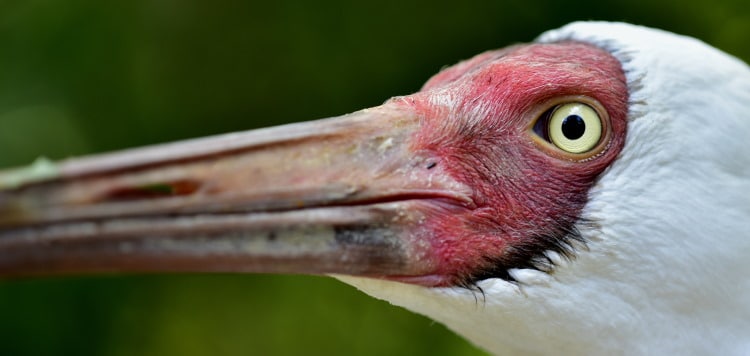
Most species of cranes moult during the breeding season, after their eggs have hatched. This makes ecological sense – because while they are moulting their flight feathers they cannot fly. However, once the chicks have hatched, they have little desire to fly anywhere anyway – as the chicks follow their parents much of the time and they cannot fly either.
During this time, cranes are often difficult to see as they tend to use the areas of their territoty with those densest vegetation.
All cranes are aggressive and territorial birds during the breeding season, normally requiring large, multiple square kilometre territories which are vigorously defended against all conspecific intruders.
Crane Migration
Young cranes grow quickly and in the migratory species are soon ready to make the often arduous flights which take them to their wintering habitats. Cranes like to fly at between 1,000 and 2,000 metres (5,000ft) high, which means they are unlikely to be seen flying overhead – unless they are just taking off or alighting.
However, several species cross the Himalayas in their migratory flights and they have been recorded from passing aeroplanes flying at heights as great as 6,000 to 7,000 metres (20,000ft).
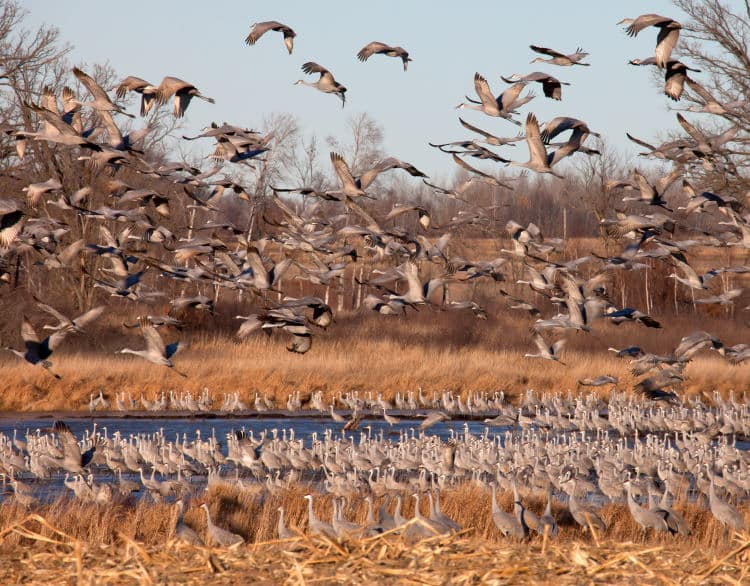
Cranes are strong fliers, though they glide as much as possible when on long journeys. Still they can easily cover several hundred kilometres in a flight session, but many of them still have to take their migrations in a series of steps.
Thus radio-tracking of migrating Cranes has revealed that they they have several stop-overs on their flights each way. During these stop-overs they feed and rest, building up their strength for the next part of the journey. Some of the longest journeys are made by the Sandhill Cranes that overwinter in Northen Mexico and breed in North-Eastern Russia.
Preening and Mating
There is some evidence that breeding pressures created by mankind’s habit of draining wetlands is resulting in a reduction of territory size in some species/populations.
Outside of the breeding season, the birds tend to feed solitarily or in pairs. But roost communally (in flocks).
Cranes are primarily diurnal, sleeping during the night standing, preferably in water, on one leg – though the leg may be changed during the night.
Cranes usually feed during the morning and afternoon, but generally have plenty of time for non-foraging activities.
Like all birds, they spend a lot of time preening.
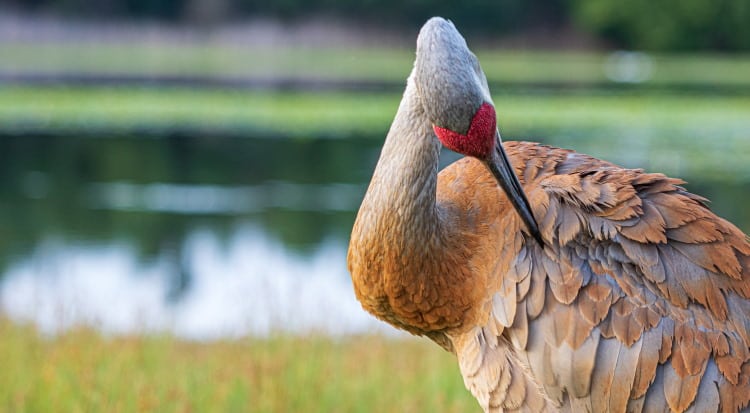
Sandhill Cranes, Eurasian Cranes and Siberian Cranes ‘paint’ themselves by preening mud into their feathers prior to the breeding season. Siberian Cranes only ‘paint’ their necks, but for the other two species, the painted feathers form part of their camouflage during the early breeding season and it is therefore much more extensive.
Cranes are long lived birds, with individuals known to have lived more than 20 years in the wild, and as much as 80 years in captivity.
They take from just over two years, to nearly seven years to reach sexual maturity.
They will mate for life, however if a partnership is unsuccessful the two will separate and look for new partners. Also if one partner dies, the remaining partner will look for another mate. First time breeders are often not successful, and it may take young birds several breeding seasons before they get competent at breeding.
All Cranes dance. Dances involve wing spreading and flapping, prancing and jumping.
During the jumps, the birds may rise several body heights into the air. Adolescent birds dance most frequently and dancing plays a role in early mate selection. Newly mated pairs use dancing to reinforce the pairbond, as well as in territorial defence.
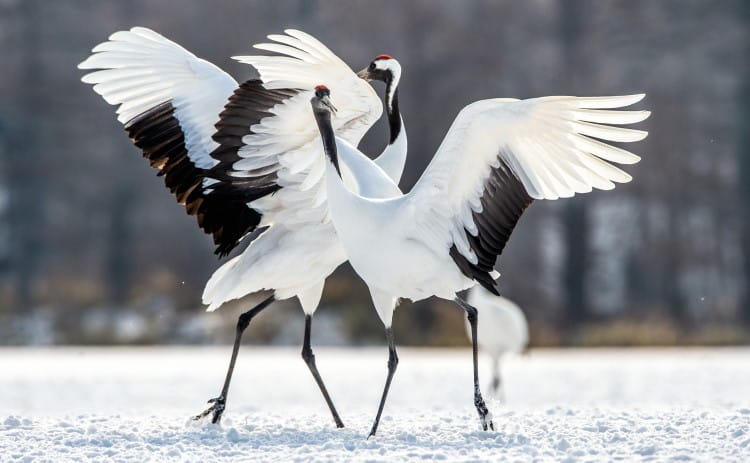
Older birds use dancing less often, though it can be stimulated by nervousness. Birds not only dance during the breeding season, but also in the non-breeding flocks – where dancing may become a contagious activity that spreads rapidly through a flock. Courtship dances can last for hours.
Postures, Displays and Calls in Cranes
Cranes communicate with each other by means of ritualised postures called displays and through calls.
Displays can be aggressive or submissive.
Aggressive displays are called threat displays and given various names by scientists – they all involve facing the cause of the display. Submissive displays often look like displays of dignity, as they involve the birds elevating their body feathers and walking away.
Cranes are renowned for their calls, particularly their ‘unison calls’.
These are calls made by pairs of birds to reinforce the pairbond and to warn neighbouring pairs to stay off their territory. It also helps the pair come into breeding readiness (physiologically) together and seems to have a direct role on the development of the female’s ovaries.
Some species have extra long trachea (wind pipes) that are coiled inside the bird’s upper body. The extra length of the trachea allows the birds to make lower, louder calls.
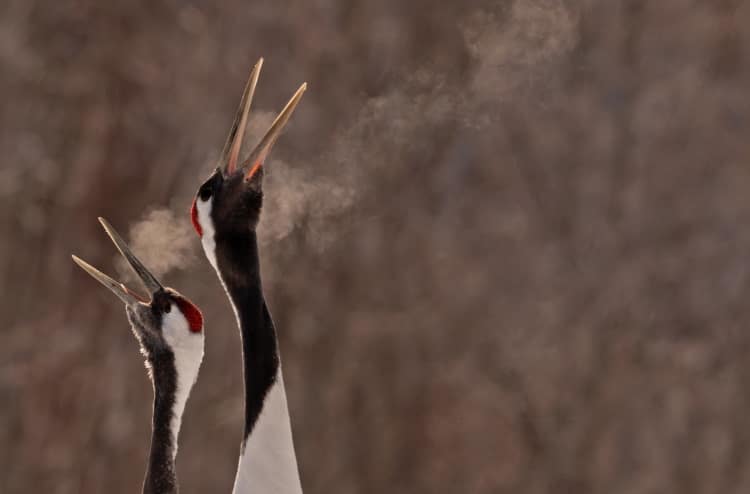
Lower sounds are important in the breeding grounds of Northern and Northeastern Asia, where pairs may be kilometres apart, as low sounds travel further than higher pitched sounds.
The unison calls of new pairs are less well co-ordinated than those of long established pairs. Unison calls last for up to a minute at a time and are typically made when one of a pair returns to the nest.
Siberian Cranes are noted for the clear, flute-like quality of their voice. In the cranes of the genus Grus, the sexes have distinct voices and they call different parts of the unison call (the exception to this is the Siberian Crane.).
Cranes, like other birds, also have a number of other calls such as ‘guard calls, ‘location calls’ and ‘precopulatory calls’.
Height, Weight and Wingspan of the living Cranes.
Values are in metric and imperial measurements. The values are all averages as supplied by the International Crane Foundation 2002.
| Common Name | Scientific Name | Wing-span m (ft) | Height m (ft) | Weight kg (lbs) |
|---|---|---|---|---|
| Black Crowned Crane | Balearica pavonina | 0.92m (3) | 3.64kg (8) | |
| Grey Crowned Crane | Balearica regulorum | 0.92m (3) | 3.64kg (8) | |
| Demoiselle Crane | Anthropoides virgo | 0.92m (3) | 2.50kg (6) | |
| Blue Crane | Anthropoides paradisea | 1.23m (4) | 5.00kg (11) | |
| Wattled Crane | Bugeranus carunculatus | 1.85m (6) | 6.36kg (14) | |
| Siberian Crane | Grus leucogeranus | 1.54m (5) | 5.91kg (13) | |
| Sandhill Crane | Grus canadensis | 0.92m (6) | 1.23m (4) | 4.55kg (10) |
| Sarus Crane | Grus antigone | 2.46m (8) | 1.85m (6) | 6.36kg (14) |
| Brolga | Grus rubicundus | 1.85m (6) | 1.54m (5) | 8.18kg (18) |
| White-naped Crane | Grus vipio | 1.23m (4) | 5.45kg (12) | |
| Hooded Crane | Grus monachus | 0.92m (3) | 3.64kg (8) | |
| Eurasian Crane | Grus grus | 2.15m (7) | 1.23m (4) | 4.55kg (10) |
| Whooping Crane | Grus americana | 2.15m (7) | 1.54m (5) | 7.27kg (16) |
| Black-necked Crane | Grus nigricollis | 1.23m (4) | 5.45kg (12) | |
| Red-crowned Crane | Grus japonensis | 1.54m (5) | 7.73kg (17) |
Reproductive Ecology
Cranes breed at different times of year, depending on species and where they live.
Some species will also adjust their breeding to the weather conditions prevalent in a particular year. This applies particularly to the non-migratory species in Africa, who are strongly effected by the prevalence of the seasonal rains.
Nests are normally built of vegetation, lined with some dry grass and may be several metres across. The nests of most species tend to be built near the edges of, or within, wetlands – often hidden within dense vegetation (reeds etc.).
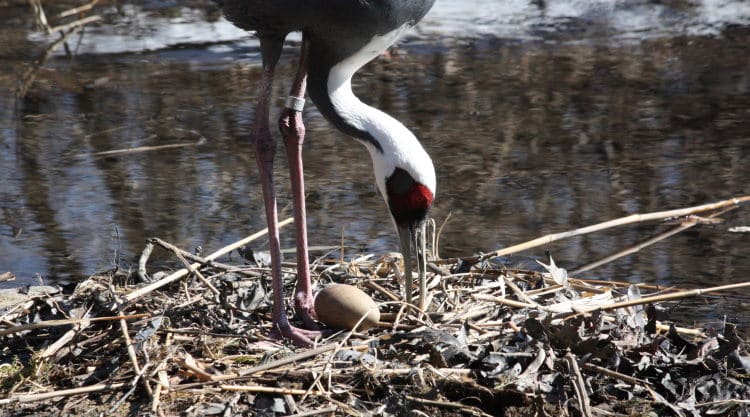
Demoiselle and Blue cranes are the least aquatic and build their nests in dry prairie or savanna nearby a wetland.
Young birds may build several nests in their first year without laying any eggs. Then the following year, a few nests are built again and one is used. Experienced breeders seem to know better where to build and don’t waste their efforts building more than one nest.
The eggs are normally incubated by both parents and the hatched young normally leave the nest within a few days of hatching – and follow their parents to a safer spot, where they remain hidden. As they get older they follow their parents out to feed.
Although they do not have webbed feet, Cranes can swim quite well. Young birds may often have to swim while following their parents across the wetlands, when they are traversing areas too deep for their young legs to allow them to walk.
Crane Breeding Ecology
Eggs = Average number of eggs, (2-1 means two eggs are laid but only one raised); Incu. = Incubation period in days; Fledg. = Time until fledging of the young in days
| Common Name | Scientific Name | Season | Nest Site | Eggs | Incu. | Fledg. |
|---|---|---|---|---|---|---|
| Black Crowned Crane | Balearica pavonina | Sep-Feb | Wetland edges | 2.5 | 28-31 | 60-100 |
| Grey Crowned Crane | Balearica regulorum | Jun-Sep | Wetland edges | 2.5 | 28-31 | 56-100 |
| Demoiselle Crane | Anthropoides virgo | Apr-Jun | Grasslands | 2 | 27-29 | 55-65 |
| Blue Crane | Anthropoides paradisea | Sep-Feb | Grass/Sedgelands | 2 | 30-33 | 90-150 |
| Wattled Crane | Bugeranus carunculatus | Aug-Sep | Floodplains | 44563 | 33-36 | 90-130 |
| Siberian Crane | Grus leucogeranus | May-Jul | Shallow water | 44563 | 27-30 | 70-75 |
| Sandhill Crane | Grus canadensis | May-Aug | Wetland edges | 2 | 29-32 | 67-75 |
| Sarus Crane | Grus antigone | All Year1 | In Wetlands | 4 | 31-34 | 85-100 |
| Brolga | Grus rubicundus | Variable2 | Wetland Edges | 2 | 28-31 | 90-100 |
| White-naped Crane | Grus vipio | Apr-Jul | Wetland Edges | 2 | 28-32 | 70-75 |
| Hooded Crane | Grus monachus | Apr-Jul | Taiga | 2 | 27-30 | 65-75 |
| Eurasian Crane | Grus grus | Apr-Jul | Wetlands | 2 | 28-31 | 65-70 |
| Whooping Crane | Grus americana | Apr-Jul | Wetland Edges | 2 | 29-30 | 80-90 |
| Black-necked Crane | Grus nigricollis | May-Aug | Wetlands | 2 | 30-33 | 85-95 |
| Red-crowned Crane | Grus japonensis | Apr-Jul | Wetlands |
1. There are 3 subspecies of Sarus. The Indian Sarus breeds Jul-Apr, the Eastern Sarus May-Oct and the Australian Sarus Apr-Nov.
2. There are two main populations of Brolgas in Australia, Northern and Southern. The Northern population breeds Jan-Jul and the Southern population breeds May-Dec.
Final Thoughts
Well, I hope this has been a useful introduction to the wonderful world of cranes!
They are truly wonderful birds. Perhaps now you’d like to learn a bit more about birds of paradise.

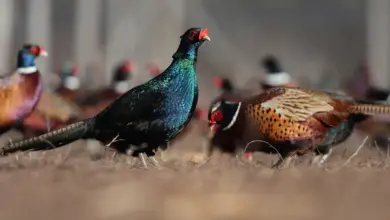
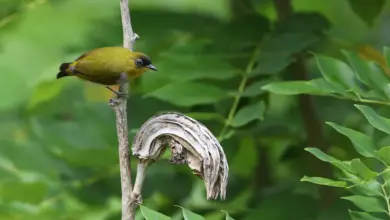



Hi,
Thank you for all your information. Very interesting. Well, we have just had a very pleasant surprise as we saw a crane on our back garden fence. Given that we live in Cheshire UK, and have never seen a crane for real and especially not in our own back garden, we are dumbfounded. We tried to get a good picture as quickly as possible but aS my husband clicked, the bird took off. This is the best we could do. What type of crane is it please?
It won’t allow me to paste the picture, unfortunately. The bird seemed young, was predominantly white, with some mottled grey markings on its long neck and darker grey wings/tail. Two, what appeared. to be black stripes in each of its wings towards tips. That’s the best I can do, I’m afraid. Thank you in advance for your expertise on the matter.
Hi,
I am assuming you would have recognized a Grey heron, so that leaves three possibilities. The Common crane (Grus grus) is the only resident crane in the UK, and therefore the most likely suspect. The other two options, the Sandhill crane (Antigone canadensis) from the US and Demoiselle Crane (Grus virgo) from Eastern Europe and beyond are both extremely rare occurrences in the UK. The Sandhill crane as a vagrant migrant and the Demoiselle as an escapee from bird parks. I suggest you search search Google images for pictures of juveniles of the three species and compare them with your photo and your memory.